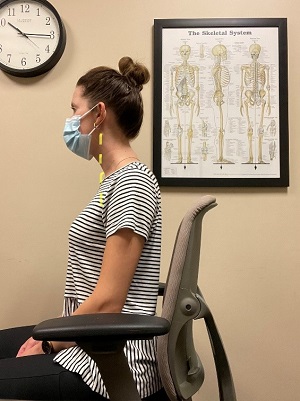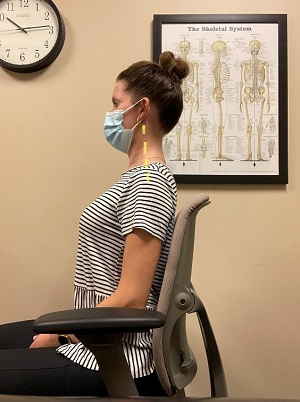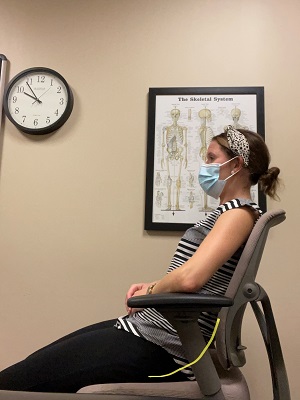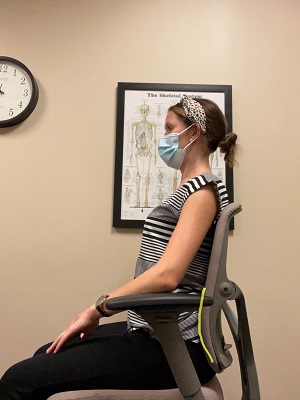
4 Back-to-School Posture Tips for Students
Leave a CommentWhen the school supplies take over store aisles and the daylight hours begin to shorten, one can sense that back-to-school time is here. Be sure your return is pain-free! Here are four tips for decreasing strain on your spine and improving the ergonomics of your school experience.
1. Keep Your Head Up
Technology has provided students with many advantages; however, it has resulted in students spending a lot more of their school time on devices. Devices such as laptops, tablets, and cell phones can encourage Forward Head Posture (FHP). Optimal posture is when the earlobe is aligned relatively vertical to the center of the shoulder when viewed from the side. FHP is when the head is positioned forward relative to the shoulders. When the head sits forward, the lower part of the neck is now in flexion. This increases the forces on the cervical spine because it is no longer in a stable, upright alignment. If the head is tilted forwards only 30 degrees, there is 40 pounds of force on the neck, or cervical spine, which is approximately four times the head’s weight alone.1
 |
 |
| Forward Head Posture (incorrect posture) | Optional posture (earlobe aligned with center of shoulder) |
Does FHP result in neck pain? There may not be a correlation between FHP and neck pain in adolescents, but there does appear to be a link between FHP and neck pain in adults.3 Therefore, children and teens should avoid creating a habit of looking down excessively when using devices because it can train their head and neck to function in a forward position and lead to discomfort or pain in the future.
You can minimize your tendency to assume a forward head by setting up your study area for success. Aim to position your laptop or computer as close to eye level as possible. Adjust the computer monitor height, utilizing a laptop stand, or improve with a stack of textbooks or paper reams. Your arms should rest comfortably by your sides supported on the armrests of a chair or the desktop surface. If you are looking down at a device for an extended period of time, give your neck a break by doing some range of motion exercises approximately every 30 minutes:
- Look up
- Tilt your head towards one shoulder then the other
- Gently turn your head from side to side.
2. Sit Smart
You may not have much choice over your seating arrangements if you are attend classes in person, but try to avoid slouching in the chair. General rules for sitting posture are: Position your hips to the back of the chair and keep both feet flat on the floor (avoid crossing your legs or tucking one foot under a thigh). There should be a slight curve in your lower back; you want to prevent your hips from rolling under and the lower back slumping.
 |
 |
| Incorrect posture | Correct posture |
If you have lower back pain when sitting, you may use a rolled-up towel placed at the curve of your lower back to improve the support at your lumbar spine. If you’re in virtual classes, aim to stand up and walk around a bit in-between lectures, even though you don’t need to transport yourself to your next class physically. This will give your hip flexors a break from holding you up and activate the muscles on the back of your legs that have been on stretch while in a seated posture. It may be worth investing in a comfortable and supportive chair for your home desk if you will be attending classes virtually for an entire semester or year.
3. Pack Your Bag
The backpack is the quintessential student bag. But can it be bad for kids and teens? Studies have shown that backpacks can cause FHP when they weigh more than 10% of the student’s body weight.3 Carrying a heavy bag on one shoulder, such as a tote bag or gym bag, can cause the wearer to hike up their shoulder or lean towards the opposite side. This can create unwanted muscle tension or muscle knots around the neck, shoulder, or lower back, becoming painful. So try not to pack more than what you need for the day, and distribute the weight evenly between both shoulders when possible. Be mindful that your head and shoulders are not flexing or rounding forwards more than necessary when carrying a bag. If you are standing or sitting on public transportation, you can wear or position the bag in front of you, which reduces the strain on the neck and shoulders compared to when it is hanging on your back.
4. Focus on Fitness
While you can’t completely control the number of hours you will spend sitting per day as a student, you can influence how you spend your time outside the classroom. Sedentary activities such as texting, scrolling social media apps, playing video games, or watching TV involve additional time sitting and hunched over devices, resulting in further strain on the spine and surrounding muscles from faulty posture. Make it a priority to do something active to counteract your sitting time and engage your muscles in different patterns and postures. The American College of Sports Medicine recommends children and adolescents accumulate a minimum of 60 minutes of physical activity daily as part of transportation, physical education, sport, free play, and planned exercise.4
Back-To-School Pain? We Can Help
Persistent lower back or neck pain in children and adolescents is not normal. So if your student is having pain, it is recommended to consult with their pediatrician or another licensed health care provider such as a physical therapist to determine the best course of action to restore pain-free function. Don’t know where to start? Reach out to an Athletico near you to schedule a Free Assessment where our experts can assess your student’s pain and provide recommendations to help them feel better faster.
The Athletico blog is an educational resource written by Athletico employees. Athletico bloggers are licensed professionals who abide by the code of ethics outlined by their respective professional associations. The content published in blog posts represents the opinion of the individual author based on their expertise and experience. The content provided in this blog is for informational purposes only, does not constitute medical advice and should not be relied on for making personal health decisions.
References
1. Neupane, Sunil, et al. “Text Neck Syndrome – Systematic Review.” Imperial Journal Interdisciplinary Research,
vol. 3, no. 7, 2017, pp. 141–147, www.onlinejournal.in/IJIRV3I7/028.pdf. Accessed 19 Aug. 2021.
2. Mahmoud, Nesreen Fawzy, et al. “The Relationship between Forward Head Posture and Neck Pain: A Systematic Review and Meta-Analysis.” Current Reviews in Musculoskeletal Medicine, vol. 12, no. 4, 26 Nov. 2019, pp. 562–577.
3. Mohan, Mayank, et al. “Effect of Backpack Loading on Cervical and Shoulder Posture in Indian School Children.” Indian Journal of Physiotherapy and Occupational Therapy, vol. 1, no. 2, 2017.
4. “Physical Activity in Children and Adolescents.” www.acsm.org, American College of Sports Medicine, 2015, www.acsm.org/docs/default-source/files-for-resource-library/physical-activity-in-children-and-adolescents.pdf?sfvrsn=be7978a7_2#:~:text=Children%20and%20adolescents%20should%20accumulate,of%20moderate%20and%20vigorous%20intensity.. Accessed 19 Aug. 2021.Note: Quotation reprinted with permission of the American College of Sports Medicine.
